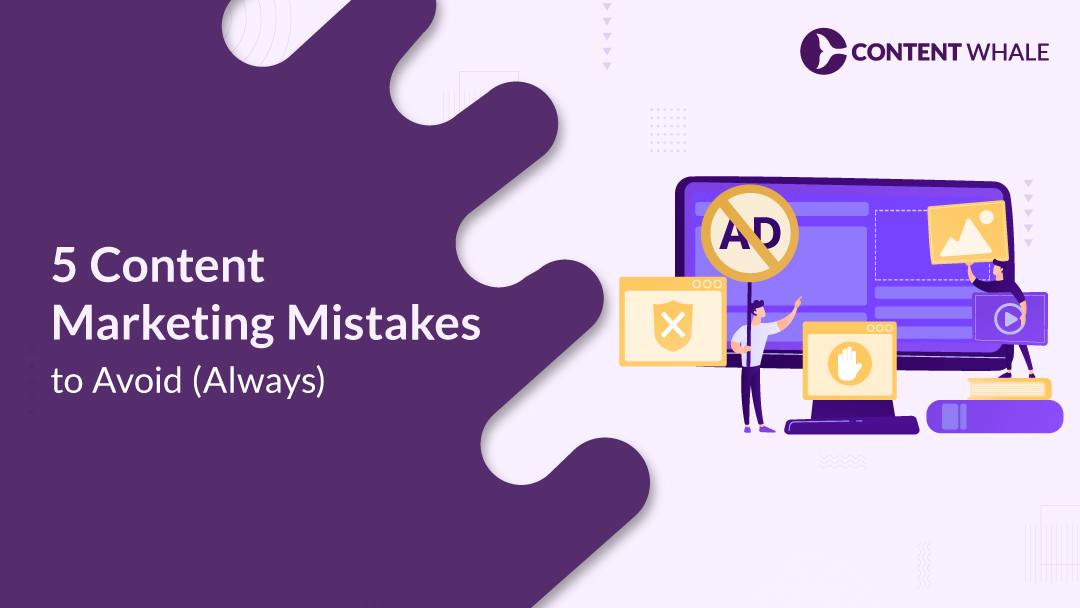Quick Summary
Identify and avoid common content marketing mistakes to boost your content strategy. Discover practical marketing tips for improving online content and avoiding common content pitfalls. Learn content marketing best practices to avoid content creation errors and ensure your strategy is free of digital marketing mistakes.
Content marketing is an essential component of modern digital strategies, enabling businesses to engage with their audience, build brand awareness, and drive conversions. Despite its importance, many marketers still fall into common content marketing mistakes that can significantly hinder their efforts and lead to ineffective content. Understanding these pitfalls is crucial for refining your content strategy and ensuring its success.
One prevalent issue is the absence of a structured plan, leading to disjointed efforts and missed opportunities. Effective content planning involves setting clear goals, understanding your target audience, and consistently evaluating performance to make necessary adjustments. Without these steps, businesses often face content creation errors that diminish the impact of their campaigns.
Moreover, digital marketing mistakes such as neglecting SEO or failing to adapt to changing trends can severely limit the reach and effectiveness of your online content. Staying updated with content marketing best practices and continuously optimizing your content based on data insights are vital for overcoming these challenges.
This article will highlight some of the most common content marketing mistakes and offer practical marketing tips to help you avoid these content pitfalls. By addressing these marketing errors, you can enhance the effectiveness of your content, ensuring it resonates with your audience and achieves your business objectives. Implementing these strategies will ultimately lead to more engaging and successful content marketing efforts.
Content Marketing Mistakes #1: Lack of Clear Strategy
Not having a clear content strategy is one of the most critical content marketing mistakes. When businesses lack well-defined goals and objectives, their content efforts can become unfocused and disorganized, leading to ineffective content. This disarray can result in wasted resources and missed opportunities to engage with the target audience effectively.
Consequences of Not Having Clear Goals and Objectives
Without clear goals, it’s challenging to measure the success of your content marketing efforts. You may find yourself producing online content that doesn’t align with your business objectives, leading to poor engagement and low conversion rates. Additionally, the absence of a strategic direction can cause inconsistency in content quality and posting schedules, further alienating your audience.
Steps to Create an Effective Content Strategy
1. Set Specific Goals
Begin by defining what you want to achieve with your content. Whether it’s increasing brand awareness, generating leads, or boosting sales, your goals should be specific, measurable, achievable, relevant, and time-bound (SMART).
2. Understand Your Audience
Conduct thorough audience research to gain insights into your audience’s preferences, pain points, and needs. Use tools like surveys, social media analytics, and customer feedback to gather this information.
3. Content Planning
Develop a content calendar to plan your topics, formats, and publishing schedule. This helps ensure consistency and allows you to align your content with key events and dates in your industry.
4. Optimize for SEO
Incorporate keyword research into your planning to ensure your content is discoverable. Avoid common digital marketing mistakes like neglecting SEO, which can limit your reach.
5. Regular Review and Adjustment
Use analytics tools to track the performance of your content. Regularly review this data to make informed adjustments to your strategy, ensuring it remains relevant and effective.
By following these steps and avoiding marketing errors, you can create a robust content strategy that drives better engagement and achieves your business goals. Implementing content marketing best practices ensures your efforts are both efficient and impactful.
Content Marketing Mistakes #2: Ignoring Audience Research
One of the most detrimental content marketing mistakes is ignoring audience research. Understanding your target audience is fundamental to creating relevant and engaging online content. When you overlook this step, you risk producing ineffective content that fails to resonate with your audience, leading to poor engagement and low conversion rates.
Pitfalls of Not Understanding Your Target Audience
Without proper audience research, your content may miss the mark entirely. You might end up addressing issues that are irrelevant to your audience, or using a tone and style that does not appeal to them. This can lead to significant content pitfalls, such as high bounce rates and low return on investment. Additionally, failing to understand your audience’s needs and preferences can result in content creation errors and wasted resources.
Techniques for Conducting Audience Research
1. Surveys and Questionnaires
These tools can provide valuable insights into your audience’s preferences, needs, and behaviors. Asking targeted questions helps you gather specific information that can inform your content strategy.
2. Social Media Listening
Monitor social media platforms to understand what your audience is talking about, what they care about, and how they interact with brands. This can reveal trends and pain points that your content can address.
3. Website Analytics
Use tools like Google Analytics to track user behavior on your site. Analyze which pages have the most visits, the longest dwell times, and the highest bounce rates to understand what content is working and what needs improvement.
4. Focus Groups and Interviews
Engaging directly with a select group of your audience can provide deeper insights into their preferences and experiences. This qualitative data complements the quantitative data from surveys and analytics.
5. Competitor Analysis
Look at what your competitors are doing and how their audience responds. This can give you ideas for your own content and help you identify gaps in the market.
By implementing these techniques, you can avoid marketing errors and create a more effective and targeted content strategy. This approach ensures that your content is not only engaging but also aligned with your audience’s needs, leading to better results and higher engagement.
Content Marketing Mistakes #3: Inconsistent Posting
Inconsistent posting is a common content marketing mistake that can significantly hinder your efforts to build and maintain an engaged audience. Regular posting is essential for keeping your brand top of mind and ensuring steady growth in followers and engagement.
Negative Effects of Irregular Posting Schedules
Irregular posting can lead to decreased visibility and engagement. When you don’t maintain a consistent schedule, your audience may lose interest or forget about your brand altogether. This can result in lower traffic, reduced social media interactions, and ultimately, fewer conversions. Additionally, search engines and social media algorithms favor sites and profiles that publish fresh content regularly, so inconsistent posting can negatively impact your SEO and online presence.
Tips for Maintaining a Consistent Content Calendar
1. Create a Content Calendar
Plan your content in advance to ensure you have a steady stream of posts. A content calendar helps you organize topics, set deadlines, and coordinate across different platforms.
2. Use Scheduling Tools
Utilize tools like Hootsuite or Buffer to schedule posts ahead of time. This ensures your content goes live at optimal times, even if you’re busy with other tasks.
3. Repurpose Content
Maximize your content by repurposing it across different formats and platforms. For instance, turn a blog post into a series of social media posts or a video.
4. Set Realistic Goals
Determine a posting frequency that you can realistically maintain. It’s better to post quality content less frequently than to post low-quality content just to meet a self-imposed quota.
Examples of Effective Posting Strategies
Brands like HubSpot and Hootsuite exemplify effective posting strategies. They maintain a regular posting schedule and use a mix of content types to keep their audience engaged. Their consistent efforts help them build a loyal following and improve their SEO rankings.
By avoiding these content pitfalls and following content marketing best practices, you can maintain a consistent posting schedule that enhances your content strategy and drives better results.
Content Marketing Mistakes #4: Overlooking SEO

Neglecting SEO is a significant content marketing mistake that can greatly reduce your content’s visibility and effectiveness. Ensuring your online content is optimized for search engines is essential for attracting organic traffic and achieving your marketing goals.
Common SEO Mistakes to Avoid
1. Ignoring Keyword Research
One of the most frequent digital marketing mistakes is not conducting thorough keyword research. Using irrelevant or overly competitive keywords can prevent your content from ranking well. Instead, focus on identifying and incorporating relevant keywords that your target audience is searching for.
2. Duplicate Content
Duplicate content confuses search engines, making it hard to determine which version to rank. This can lead to lower visibility for all versions of the duplicated content. Always strive for unique, valuable content to avoid this issue.
3. Neglecting On-Page SEO
On-page elements like title tags, meta descriptions, and header tags play a significant role in SEO. Ensure these elements are optimized with relevant keywords and provide clear, concise information about your content.
4. Poor Mobile Optimization
With the increasing use of mobile devices, having a mobile-friendly website is crucial. Ensure your site is responsive and loads quickly on all devices to improve user experience and SEO rankings.
5. Lack of Regular Content Updates
Search engines favor fresh, updated content. Regularly review and update your content to keep it relevant and engaging, which can improve your search engine rankings.
Best Practices for Optimizing Content for Search Engines
1. Use Relevant Keywords
Incorporate keywords naturally into your content, including in titles, headers, and throughout the body text. Avoid keyword stuffing, which can negatively impact your SEO.
2. Optimize Images
Use descriptive file names and alt text for images to enhance accessibility and improve SEO. Compress images to reduce load times without compromising quality.
3. Build Quality Backlinks
Earn backlinks from reputable sites to increase your content’s authority and improve search engine rankings. Focus on creating high-quality content that naturally attracts links.
4. Conduct Regular SEO Audits
Periodically audit your site to identify and fix any SEO issues. This includes checking for broken links, duplicate content, and ensuring all on-page elements are optimized.
By following these content marketing best practices and avoiding common marketing errors, you can improve your SEO, enhance your content strategy, and achieve better visibility and engagement for your content.
Content Marketing Mistakes #5: Poor Content Quality
Producing low-quality content is a significant content marketing mistake that can greatly damage your brand’s reputation and reduce audience engagement. High-quality online content is essential for building trust and driving conversions.
Impact of Low-Quality Content on Audience Engagement
Low-quality content can drive your audience away, leading to high bounce rates and lower time spent on your site. This not only affects user engagement but also negatively impacts your SEO rankings, as search engines favor content that keeps users engaged. Additionally, poor content quality can erode your audience’s trust, making them less likely to return to your site or recommend your brand to others. This is a common pitfall that many businesses face, leading to digital marketing mistakes that hinder growth.
Characteristics of High-Quality Content
1. Relevance and Value
Your content should provide valuable information that addresses the needs and interests of your audience. Content that offers practical insights and solutions is more likely to engage and retain readers.
2. Originality
Ensure that your content is unique and offers a fresh perspective. Avoid duplicating content from other sources, as this can lead to SEO penalties and diminish your credibility.
3. Clarity and Readability
High-quality content is well-structured, easy to read, and free of grammatical errors. Use clear headings, bullet points, and short paragraphs to enhance readability.
4. Visual Appeal
Incorporate relevant images, infographics, and videos to make your content more engaging. Optimizing these visual elements for SEO can also help improve your search engine rankings.
Tips for Improving Content Quality
1. Thorough Research
Invest time in researching your topics to provide accurate and detailed information. This helps establish your authority and credibility in your industry.
2. Audience Feedback
Regularly seek feedback from your audience to understand their preferences and improve your content accordingly. This can help you avoid common content creation errors.
3. Regular Updates
Keep your content up-to-date to ensure it remains relevant and valuable to your audience. Regular updates can also boost your SEO rankings.
By focusing on these content marketing best practices and avoiding content pitfalls, you can enhance the quality of your content and achieve better results in your content marketing efforts.
Conclusion

Avoiding common content marketing mistakes is essential for any business looking to maximize its digital presence and engagement. A well-executed content strategy helps in establishing authority, building trust, and driving conversions. To summarize, here are the key takeaways to implement:
Recap
- Clear Strategy: Start with well-defined goals and objectives. Regularly review and adjust your strategy based on performance data to ensure continuous improvement.
- Audience Research: Conduct thorough audience research to understand your target demographic’s preferences and needs. Tailor your content to meet these expectations.
- Consistent Posting: Maintain a regular posting schedule to keep your audience engaged and improve SEO rankings.
- SEO Optimization: Ensure your content is optimized for search engines by incorporating relevant keywords, optimizing images, and building quality backlinks.
- High-Quality Content: Focus on creating valuable, unique, and well-researched content to establish authority and build trust with your audience.
Encouragement to Implement Best Practices
Implementing these content marketing best practices will help you avoid content pitfalls and marketing errors. This strategic approach not only enhances audience engagement but also improves your overall marketing effectiveness.
Final Thoughts
Consistently delivering high-quality, well-optimized content tailored to your audience’s needs is the key to a successful content marketing strategy. Regularly evaluate your performance, adapt to new trends, and stay committed to your content goals. This proactive approach will ensure sustained growth and success in your content marketing efforts.
FAQs
1. How can I develop a clear content strategy?
Creating a clear content strategy involves setting specific, measurable goals that align with your business objectives. Start by understanding your target audience through thorough research, which helps in tailoring content to their needs. Develop a content calendar to plan and organize your content topics and publishing schedule. Regularly review and adjust your strategy based on performance metrics to ensure it remains effective and relevant.
2. What are the best methods for audience research?
Effective audience research can be conducted using several methods:
- Surveys and Questionnaires: Collect direct feedback from your audience about their preferences and needs.
- Social Media Listening: Monitor social media platforms to understand the conversations and interests of your audience.
- Analytics Tools: Use tools like Google Analytics to gather data on audience behavior and preferences.
- Competitor Analysis: Study what your competitors are doing and how their audience is responding to their content.
3. How often should I post new content?
Consistency is key in content marketing. While the ideal posting frequency can vary, maintaining a regular schedule helps in building and retaining an audience. For many businesses, posting new content at least once a week is a good starting point. Use a content calendar to plan and schedule your posts to ensure consistency.
4. What are the key elements of SEO for content marketing?
Key elements of SEO in content marketing include:
- Keyword Research: Identify and use relevant keywords naturally in your content.
- On-Page SEO: Optimize meta tags, headers, and images.
- Quality Content: Ensure your content is valuable and engaging to attract backlinks and improve rankings.
- Mobile Optimization: Make sure your content is accessible and performs well on mobile devices.
5. How can I ensure my content maintains high quality?
Maintaining high-quality content involves:
- Thorough Research: Provide accurate and comprehensive information.
- Clear and Engaging Writing: Ensure your content is well-written, error-free, and easy to read.
- Regular Updates: Keep your content up-to-date to maintain its relevance.
- Audience Feedback: Regularly seek and incorporate feedback from your audience to improve your content.





